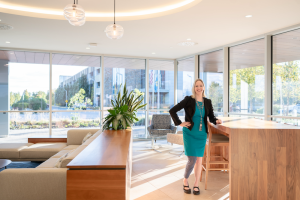
If you are part of the CIONIC community, undoubtedly you have met Jan. Her incredible story was first featured on CBS Bay Area while she was part of our original home trial, and she has been a shining light in our community ever since we first met her almost two years ago. Jan has a diagnosis of cerebral palsy, and as we think about some of the incredible individuals who have inspired the work we are doing at CIONIC, and as we acknowledge Cerebral Palsy Awareness Month this March, we had a chance to talk to Jan. As always, she was an inspiration!
It’s CP Awareness Month — what does that mean to you?
Well, it’s interesting, because the entire concept of a month to honor CP is so new to me. I’ve had this condition since birth — we’re talking 1951 — and I didn’t even know there was a month or a day until maybe last year when I first heard about it on social media.
But I do know how impactful awareness is. For example, [prominent disability rights activist] Judy Heumann was such a trailblazer, and her story is very close to mine. She was able to go to regular ed schools, and she had to fight to do that. She really worked to make a difference in such a visible, vocal way, and a political way. I know my condition also exposed a lot of kids and families to otherness. And I often had special needs kids placed in my classroom [when I was teaching], because the school district knew that I knew something of the road that those families were walking.
So what does it mean to me? I think the awareness around mobility differences has changed so dramatically in my lifetime. When I think of the way children treated me — were permitted to treat me — in elementary school, and the way that would be unconscionable and just simply not allowed today. I’m so grateful for that.
Having a month to have people focus and be aware of different conditions is a really good thing. It means that society has evolved to be so much more inclusive than it was 60, 65 years ago. You know, the children in my classroom never saw my condition. On the first day of school, sure, they might have had questions. But once they got their questions about “Mrs. G’s legs” answered, they didn’t see CP, they saw me. All it takes is getting to know a person. That’s what awareness can do — having a month to spotlight conditions represents societal evolution, to me.
As we think about awareness, what’s one thing you wish people understood or knew about having mobility differences?
I’m a whole lot more than walking differently. Every person with a difference or disability is so much more than what the world sees. Give me — the person — a minute and look past “it” — the CP. Yes, it takes me time to get to a chair and sit down. And yes, it takes me time to stand up, and it may look awkward and uncomfortable, but this is how I do it. It’s how I move, but it’s not me.
Another thing is how you offer help out in the world. In my family, everyone knows to ask ‘Can I help you?’ My husband does it all the time. I think his most used phrase to me is, “Can I help you?” and my most used phrase to him is, “Thank you.” I don’t always need help, so if I say no, then I’m grateful for the offer, but I mean it when I say no.
What are some of your guiding principles when it comes to movement?
My mother lived by four things after my dad died. She really needed to pull herself up and pull herself together. They were in their mid-fifties, and it was really hard. She’d expected to live with him for a long time. There was a lot of anguish for her. I knew she’d reached a turning point when she called me one day, and said, “I figured out, I have four rules I need to live by. I have to do four things every day: I have to do something for myself, something for someone else, something that has to get done, and something fun.”
My mother was an athlete, and she really thrived on physical exercise. So her fun was usually tennis or golf, until she was 86! After that, her ‘something fun’ became playing bridge.
I was thinking about that today, and exercise fits all four of my mother’s rules. When you have a neurological condition like mine, decades of daily exercise is a lot! But the exercise has to happen, because that’s something I can control. So I’ve decided, I need to frame it just the way my mother did: it’s something that has to happen — it just has to get done every day.
It’s also something for somebody else, because the more mobile I am, the better it is for my family and the people around me. Exercise is also something for myself, because it’s really important to me to stay as mobile as possible. And, luckily, some of the exercises I do are fun!
Looking back, would you have any words for your younger self about exercise habits?
You know what I would say to my younger self? Do something about exercise every day. Even if you phone it in a little bit, you know, and do 20 minutes instead of an hour, or half an hour instead of more than an hour. If you do something every day — even a little something — it’s so much better.
You have been using a Neural Sleeve for almost two years now, and recently transitioned from a single sleeve to two sleeves. How is that going?
With two Sleeves, there’s definitely a learning curve. What I’ve learned is that my right leg needs more support than I expected. So that was a big mental shift for me. It’s training me to walk in a whole new way. I do feel more balanced wearing two sleeves. It’s easier and it’s challenging.
For me, mobility requires work. It’s not automatic — nothing is automatic — but [with the sleeve] it’s MORE automatic. There’s a bigger carryover for me. That has been the biggest breakthrough. I’m noticing my sleeveless gait is better than it’s been for a very long time, and my gait with my sleeves on is good.
Wearing Neural Sleeves makes my gait easier, more natural, and less labored. I feel supported.
Are there any recent moments or milestones with the Sleeve?
Yes! I recently went to a museum with my husband. The experience of being able to stand up and appreciate art — to see the exhibit at eye-level rather than being in a wheelchair — is wonderful.
I also spent several hours recently at a very large shopping mall, walking with my husband. Being able to look around and navigate crowds of people in all kinds of situations still amazes me. Wearing Neural Sleeves has all but eliminated my foot drop. Not having to manage fatigue and the constant cognitive load that foot drop requires — watching every step — remains a gift!
Finally, we talk a lot about the importance of movement. What motivates you to move?
It’s really easy. I don’t want to miss anything! I think the younger generation calls it “FOMO” or the fear of missing out. I don’t want to be sidelined, to be the person who can’t go because it’s too hard. That includes attending activities for our grandchildren — navigating school gym floors for basketball games or performances, large venues for concerts, or seeing art exhibits. Walking places where I previously haven’t had the stamina to enjoy my surroundings is key.
So that’s why — that’s what motivates me to move — I want to stay engaged with family and friends. And that’s that.





